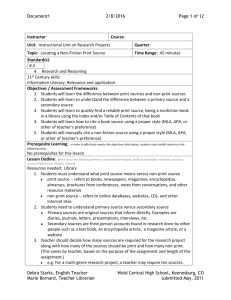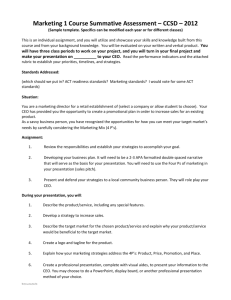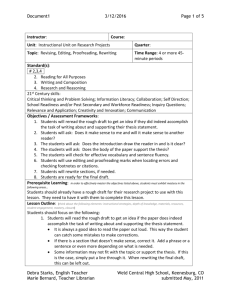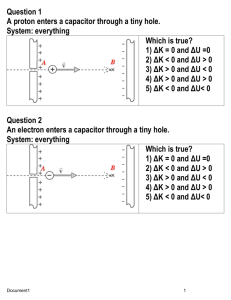Lesson plan 9
advertisement
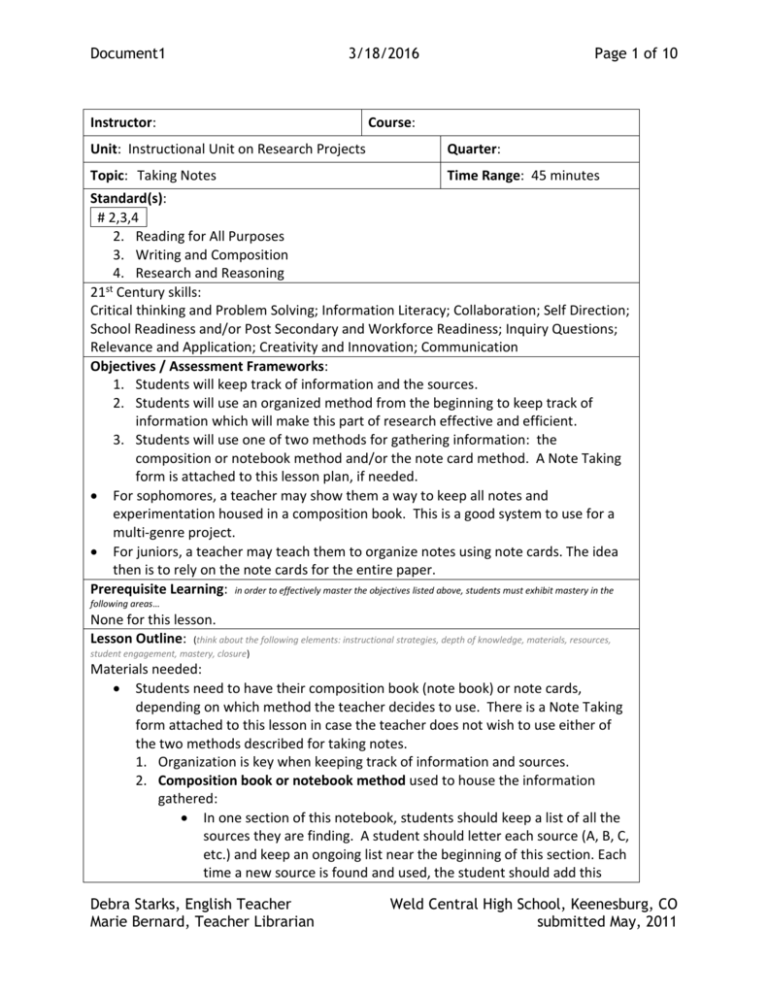
Document1 3/18/2016 Instructor: Page 1 of 10 Course: Unit: Instructional Unit on Research Projects Quarter: Topic: Taking Notes Time Range: 45 minutes Standard(s): # 2,3,4 2. Reading for All Purposes 3. Writing and Composition 4. Research and Reasoning st 21 Century skills: Critical thinking and Problem Solving; Information Literacy; Collaboration; Self Direction; School Readiness and/or Post Secondary and Workforce Readiness; Inquiry Questions; Relevance and Application; Creativity and Innovation; Communication Objectives / Assessment Frameworks: 1. Students will keep track of information and the sources. 2. Students will use an organized method from the beginning to keep track of information which will make this part of research effective and efficient. 3. Students will use one of two methods for gathering information: the composition or notebook method and/or the note card method. A Note Taking form is attached to this lesson plan, if needed. For sophomores, a teacher may show them a way to keep all notes and experimentation housed in a composition book. This is a good system to use for a multi-genre project. For juniors, a teacher may teach them to organize notes using note cards. The idea then is to rely on the note cards for the entire paper. Prerequisite Learning: in order to effectively master the objectives listed above, students must exhibit mastery in the following areas… None for this lesson. Lesson Outline: (think about the following elements: instructional strategies, depth of knowledge, materials, resources, student engagement, mastery, closure) Materials needed: Students need to have their composition book (note book) or note cards, depending on which method the teacher decides to use. There is a Note Taking form attached to this lesson in case the teacher does not wish to use either of the two methods described for taking notes. 1. Organization is key when keeping track of information and sources. 2. Composition book or notebook method used to house the information gathered: In one section of this notebook, students should keep a list of all the sources they are finding. A student should letter each source (A, B, C, etc.) and keep an ongoing list near the beginning of this section. Each time a new source is found and used, the student should add this Debra Starks, English Teacher Marie Bernard, Teacher Librarian Weld Central High School, Keenesburg, CO submitted May, 2011 Document1 3/18/2016 Page 2 of 10 source to the list. When adding the source, use the pertinent information needed for a proper works cited page. Following are 3 examples: o Book (author’s name. Title. City and publisher. Copyright date.) Bornstein, David. John Wayne-The Man Behind the Myth. San Francisco: Penguin Books, 2003. o Magazine (Author’s name. Article title. Magazine title. Date published. Page numbers.) Bacon, James. “John Wayne, the Last Cowboy”. US Today June, 1978, 68-71. o Internet (Author’s name if available. Page title. Site title. Date posted or copyright. Site sponsor. Date accessed. URL “Memorable John Wayne Quotes”. Movie Quotes posted Jan.2006.Accessed April 2006 http://www.jwayne.com /movie_quotes.shtml On another page or section the student can begin taking notes. o Be sure the student adds the letter and type of source for easy reference. o Be sure the student adds the page number from which the information came before starting to take notes. (If students do this, it will make it much easier later on because students will not need to go back and look it up. Students will already have this important information that will later be used in a citation.) A – book Pg. 36 – paraphrase or Pg. 41 – use quotation marks with exact words “ . . .” o When taking notes either paraphrase, (putting students’ ideas in their own words using essential information), or use exact words surrounded by quotation marks so the student remembers that a direct quote was used. o Students must use accurate dates and ideas and remember to always give credit for the ideas used in their paper, even if it is Debra Starks, English Teacher Marie Bernard, Teacher Librarian Weld Central High School, Keenesburg, CO submitted May, 2011 Document1 3/18/2016 Page 3 of 10 paraphrased. o For exact words, remember, students can use ellipses (…) in the quotation to show that some words have been left out. Students must give credit to the source when writing a quote in their paper. 3. Note card method: (Use index cards. It is helpful if the student uses the same size for all cards and put them on a ring or use a rubber band to keep them together and in an order) Using note cards the student will prepare one card for each source that will be lettered and have all the works cited information on it. o This card should have the student’s name in the upper left corner o In the upper right corner, the student will write a letter (A, B, C, etc). o The student will write the works cited entry on this card. o “A” will be for the student’s first source; “B” will indicate source number two; “C” will include the works cited information for his/her third source, and so on. Student Name Works cited entry A Notes will be written on the front side only of the other cards, and again, each card will have the letter of the source and then numbers following the letter in the upper right corner and their name in the upper left corner, indicating how many cards there are for each source o The top line should be left blank at first, but later, these may be filled in with topics to let the writer know what type of information is written on the card. o For the first source that is used to take notes, the first card would have the letter “A” in the upper right corner. (this card would contain works cited information only). o Notes would then be written on “A-1, A-2, A-3, A-4, A-5” or on however many cards are needed for notes from this first source. o Remember, on the cards with notes, always indicate the page number from which these notes were taken. o Students will paraphrase information on some cards and on other cards students may write exact words or quotes, using quotation marks to indicate that these are the exact words of the author. o When students have finished with notes from one source, students will go on to another source. The next first card will be lettered “B” with works cited information. o The following cards for source two would be lettered “B-1, B-2, Debra Starks, English Teacher Marie Bernard, Teacher Librarian Weld Central High School, Keenesburg, CO submitted May, 2011 Document1 3/18/2016 Page 4 of 10 B-3”, etc. o Remember to write on only one side. The reason is that later on when organizing ideas students can lay out the cards to see what information they have on certain points or sub-points. 4. ASSIGNMENT: Students need to take notes (using one of the methods mentioned) from two sources and show the teacher for credit. 5. ASSIGNMENT: An exercise on summarizing & Paraphrasing is attached, if time permits. 6. Students will continue to take notes from all sources, always giving page numbers from which the information came and always keeping track of which information came from which source. notes: Differentiation: use the data (CSAP, Acuity, TOSCRF, YPP…) collected to help identify how you will meet the needs of all students in your class. Showing examples of these types of note-taking would be helpful for students. Some will depend on the examples more than others. It would also be helpful to model the process you intend your students to use. Re-Teach Teacher will review the note taking periodically; hence, if students are not taking notes properly, this should be discovered at an early stage. Extensions Accelerations (Distributive Practice) All students use the same process for taking notes, regardless of ability; however, some student may move faster than others moving to completion sooner. This note taking will be required for each source; hence, students will have the opportunity to practice to improve note taking skills. Evaluation / Assessment: explain how you will determine mastery of this lesson to the objective/standard… Finishing the note cards for all the sources using the proper format is part of the assignment, which will show mastery for note taking. There is a question on the pre/post test asking about the purpose of note taking; therefore, it will be discovered at the time of the post test whether mastery is accomplished with this lesson. Reflection: Things that went well… Once the process is completed, students tend to finally see the benefit of the note taking process. Things that didn’t go well… Students get frustrated feeling that the note taking process is too cumbersome. They want to take the easy road of getting to the end without traveling. Things to remember… Remind students to put page numbers on the note taking cards. Things to change for next time… Debra Starks, English Teacher Marie Bernard, Teacher Librarian Weld Central High School, Keenesburg, CO submitted May, 2011 Document1 3/18/2016 Page 5 of 10 A teacher may wish to use a different design for the note taking process. Give students a ring to hold their note cards together. An exercise has been attached for summarizing and paraphrasing, if time permits. NAME _______________________ CLASS ______________ Teacher _________ Period ___ NOTE TAKING TOPIC OF RESEARCH: Print resource: summary with notes (own words); avoid plagiarism; and be sure to include page numbers Works cited information Non-print resource: summary with notes (own words); avoid plagiarism Works cited information Debra Starks, English Teacher Marie Bernard, Teacher Librarian Weld Central High School, Keenesburg, CO submitted May, 2011 Document1 Debra Starks, English Teacher Marie Bernard, Teacher Librarian 3/18/2016 Page 6 of 10 Weld Central High School, Keenesburg, CO submitted May, 2011 Document1 Debra Starks, English Teacher Marie Bernard, Teacher Librarian 3/18/2016 Page 7 of 10 Weld Central High School, Keenesburg, CO submitted May, 2011 Document1 Debra Starks, English Teacher Marie Bernard, Teacher Librarian 3/18/2016 Page 8 of 10 Weld Central High School, Keenesburg, CO submitted May, 2011 Document1 Debra Starks, English Teacher Marie Bernard, Teacher Librarian 3/18/2016 Page 9 of 10 Weld Central High School, Keenesburg, CO submitted May, 2011 Document1 Debra Starks, English Teacher Marie Bernard, Teacher Librarian 3/18/2016 Page 10 of 10 Weld Central High School, Keenesburg, CO submitted May, 2011
